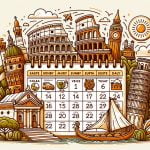Have you ever wondered what month is the best time to travel to Italy? Whether you are drawn to the historical landmarks, delectable cuisine, or stunning landscapes, choosing the right time to visit can significantly enhance your experience.
In this article, we will delve into the various factors that influence the best time to travel to Italy, such as weather and climate, tourist seasons, events and festivals, outdoor activities, and budget considerations. By understanding these elements, you can make informed decisions to ensure a memorable and enjoyable trip to this enchanting country.
Italy is a country known for its diverse climate and seasonal variations, making it essential to consider these factors when planning your visit. From the bustling cities to the tranquil countryside and picturesque coastlines, each region offers unique experiences that may be influenced by different times of the year. Understanding the weather patterns and climate conditions in Italy will play a crucial role in determining the ideal month for your travel plans.
In addition to weather considerations, exploring Italy at the best time also involves taking into account the peak tourist season and off-peak season. Each comes with its own set of advantages and challenges that can impact your itinerary and overall travel experience.
Moreover, highlighting events and festivals throughout the year will provide insight into how cultural celebrations and traditions can enrich your journey through Italy. With so much to consider when planning your trip, this article aims to guide you in determining the ultimate best month to travel to Italy based on your preferences and priorities.
Weather and Climate in Italy
Italy is known for its diverse climate and seasonal variations, providing a unique experience for travelers throughout the year. Understanding the weather patterns in Italy can greatly impact the overall travel experience, making it essential to consider when planning a trip to this beautiful country.
Spring
Spring in Italy, especially during April and May, is often considered one of the best times to visit. The weather begins to warm up, flowers bloom, and outdoor activities become more enjoyable. The temperatures are usually mild, making it ideal for sightseeing and exploring the historical landmarks without having to endure extreme heat.
Summer
The summer months in Italy, from June to August, bring warmer temperatures and bustling tourist activity. While this is peak tourist season due to the summer holidays and school breaks, it is also a popular time for beach vacations along the Italian coastline. However, visitors should be prepared for higher temperatures and larger crowds at popular attractions.
Fall
Fall in Italy is another great time to visit as the weather remains pleasant and the summer crowds start to dwindle. September and October offer comfortable temperatures and colorful landscapes as the leaves begin to change. This season is perfect for exploring wine regions or enjoying outdoor activities such as hiking or cycling before winter sets in.
Overall, there isn’t necessarily one “best” month to travel to Italy as each season offers its own unique experiences and adventures. It ultimately depends on individual preferences when considering what month is the best time to travel to Italy. Whether you prefer mild spring weather for sightseeing or a bustling summer atmosphere with beach vacations, there are plenty of options throughout the year for an unforgettable Italian getaway.
The Best Time to Visit Italy for Sightseeing and Cultural Experiences
When it comes to sightseeing and experiencing Italian culture, the best time to visit Italy is during the shoulder seasons of spring and fall. During these months, the weather is mild, and the crowds are generally smaller compared to the peak summer season. Spring in Italy, which occurs from April to June, is a fantastic time to explore the country’s stunning landscapes, historic architecture, and iconic landmarks without the intense heat of summer.
Moreover, autumn in Italy, from September to November, offers pleasant temperatures and beautiful foliage, making it an ideal time for sightseeing and immersing oneself in Italian culture. Whether you’re visiting cities like Rome, Florence, or Venice or exploring the enchanting countryside and coastal regions, spring and fall provide the perfect conditions for a rewarding cultural experience.
Additionally, visiting Italy during these shoulder seasons also means that you will have better access to popular attractions and landmarks without having to navigate through large crowds. This allows for a more intimate and immersive experience as you soak in Italy’s rich cultural heritage at your own pace.
| Month | Temperature (°F) |
|---|---|
| April – June | 60-75 |
| September – November | 65-70 |
Peak Tourist Season
The peak tourist season in Italy generally falls between the months of June and August. During these summer months, the weather is warm and sunny, making it an ideal time for beach holidays along the stunning Italian coastline. However, with the pleasant weather comes a surge in tourists, resulting in crowded attractions and higher prices for accommodations and flights.
Travelers visiting Italy during peak season can expect long queues at popular tourist spots such as the Colosseum in Rome, the Uffizi Gallery in Florence, and St. Mark’s Basilica in Venice. Additionally, popular coastal destinations like the Amalfi Coast and Cinque Terre will be bustling with tourists looking to soak up the Mediterranean sun.
Despite the crowds, there are ways to navigate through the peak tourist season in Italy. It is advisable to book accommodations and attractions tickets well in advance to avoid disappointment. Additionally, visitors can explore lesser-known areas or attractions off-the-beaten-path to escape the throngs of tourists. Alternatively, consider visiting popular attractions early in the morning or later in the evening to avoid the busiest times of day.
Off-Peak Season
Traveling to Italy during the off-peak season can offer numerous benefits that may not be available during the peak tourist season. With fewer crowds and a more relaxed atmosphere, visitors can truly immerse themselves in the Italian culture and experience the country’s charm in a whole new light.
Benefits of Off-Peak Travel
One of the main advantages of traveling to Italy during the low season is the reduced number of tourists. This means shorter lines at popular attractions, easier access to renowned landmarks, and a more authentic experience as you interact with locals without feeling overcrowded by other visitors. Additionally, accommodations and restaurants tend to be more affordable during this time, allowing travelers to enjoy all that Italy has to offer without breaking the bank.
Weather Considerations
While it’s true that Italy’s off-peak season corresponds with colder weather in many parts of the country, this can also present unique opportunities for travelers. For example, visiting cities like Venice or Florence during the winter months can provide a magical experience as you wander through snow-dusted streets and appreciate iconic landmarks against a different backdrop than what is typically seen in postcards.
Exploring Cultural Gems
During the low season, visitors have the chance to explore Italy’s cultural treasures without having to navigate through large crowds. Museums, art galleries, and historical sites are often quieter, allowing for a more intimate and leisurely exploration of some of the world’s most renowned cultural gems.
Ultimately, traveling to Italy during off-peak months presents several advantages for those seeking an authentic and budget-friendly experience. Whether it’s exploring hidden gems or savoring Italian cuisine without feeling rushed, visiting Italy during the low season can truly provide a unique and unforgettable travel experience.
Events and Festivals
Italy is a country that is rich in history, culture, and tradition, and one of the best ways to experience this is through its unique events and festivals. Each region of Italy has its own calendar of celebrations, offering visitors the opportunity to witness traditional customs and join in on the fun. Whether you’re interested in religious processions, food festivals, or historical reenactments, there’s something for everyone throughout the year.
To make the most of your visit to Italy, it’s important to plan your trip around these events and festivals. Here are some of the best times to experience Italian celebrations:
- February: Venice Carnival – One of the most famous carnivals in the world, the Venice Carnival is a spectacular event with masked balls, parades, and street performances.
- March/April: Easter – Throughout Italy, Easter is celebrated with religious processions, elaborate feasts, and special events such as Florence’s “Scoppio del Carro” (Explosion of the Cart).
- June: Siena Palio – This historic horse race takes place in Siena’s main square, Piazza del Campo, and is accompanied by colorful pageantry and festivities.
- September: Regata Storica in Venice – A historic boat race along the Grand Canal featuring gondoliers in 16th-century costumes.
- October/November: Truffle Festivals – In various regions such as Piedmont and Umbria, truffle festivals celebrate this prized culinary delicacy with tastings, markets, and cooking demonstrations.
By aligning your travel plans with these events and festivals throughout Italy, you can add an extra layer of cultural enrichment to your visit while creating unforgettable memories. Whether you’re passionate about art, music or food, there’s an Italian celebration that will surely captivate your interest.
Outdoor Activities
Italy offers a variety of outdoor activities for travelers to enjoy, from hiking in the Alps to relaxing on the beautiful beaches of the Amalfi Coast. The best time to partake in these activities largely depends on the weather and climate in different regions of Italy.
For those interested in hiking and outdoor adventures, the best time to visit Italy is typically during the spring months of April and May, as well as the early fall months of September and October. During these times, the weather is generally mild with comfortable temperatures, making it ideal for exploring the picturesque landscapes and challenging trails that Italy has to offer.
It is important to note that some mountainous regions may still have snow during this period, so it is essential to check conditions before planning any hikes.
As for beach holidays, the best time to visit Italy is during the summer months of June through August when the weather is warmest and most conducive for sunbathing and swimming. However, it is important to keep in mind that these are also peak tourist months, so popular coastal destinations may be crowded. Travelers looking for a more peaceful beach experience may consider visiting in May or September when temperatures are still pleasant but crowds are thinner.
Outdoor enthusiasts will find that Italy offers something for every season, whether it’s skiing in the winter or sailing along its stunning coastlines in the summer. Regardless of your preferred outdoor activity, there is a perfect time to travel to Italy based on your specific interests and preferences.
Budget Considerations
Italy is a country with plenty to offer all year round, but if you’re looking to make the most of your travel budget, it’s important to consider the best times to find travel deals and savings. Understanding the peak tourist season and off-peak season can play a crucial role in determining when to plan your trip to Italy.
During the peak tourist season, which typically runs from June to August, prices for accommodations, tours, and attractions tend to be at their highest due to the high demand. Additionally, crowds can be overwhelming at popular tourist destinations, which may impact your overall experience.
If you’re looking to save on your travel expenses and avoid large crowds, consider visiting during the off-peak season. This period usually falls between November and March when prices are lower, and attractions are less crowded.
Another factor to consider is the shoulder seasons, which occur in April-May and September-October. During these months, you can still enjoy pleasant weather while benefiting from fewer crowds and potentially finding better travel deals. Keep an eye out for shoulder season promotions offered by hotels, airlines, and tour operators as they often provide great opportunities for savings.
If you’re flexible with your travel dates and keen on maximizing your budget during your trip to Italy, carefully considering the timing of your visit can make a significant difference in terms of cost savings without compromising on the quality of your experience. By avoiding peak tourist seasons and taking advantage of shoulder or off-peak seasons, you can stretch your travel budget further while still enjoying everything that Italy has to offer.
Conclusion
In conclusion, determining the ultimate best month to travel to Italy ultimately depends on your personal preferences and priorities. If you are looking for ideal sightseeing and cultural experiences, the months of April, May, September, and October are generally recommended due to milder weather and fewer tourists. However, if you are interested in outdoor activities such as hiking and beach holidays, the summer months of June, July, and August may be more suitable.
It’s important to consider the peak tourist season in Italy, which typically occurs during the summer months. While this is a popular time to visit for good reason, it also means dealing with larger crowds and higher prices. If you prefer a more relaxed and budget-friendly experience, you may want to consider visiting during the off-peak season when there are fewer tourists and lower prices.
Additionally, it’s worth researching special events and festivals that take place throughout the year in Italy. Depending on your interests, attending these celebrations can enhance your overall travel experience. Ultimately, the best time to travel to Italy is subjective and varies depending on what you hope to see and do during your visit. Whether you’re seeking historical landmarks or natural beauty, considering these factors will help you determine the best month for your Italian adventure.
Frequently Asked Questions
What Is the Cheapest Month to Go to Italy?
The cheapest month to go to Italy is generally November. During this time, the tourist crowds are much thinner, and accommodation and flights tend to be more affordable. It’s a great opportunity to explore Italy on a budget.
What Month Is the Best Weather in Italy?
The best weather in Italy is typically during the months of May and September. These months offer pleasant temperatures, fewer crowds, and sunny days, making it an ideal time to explore the country without having to endure extreme heat or cold.
What Month Has the Least Tourists in Italy?
If you’re looking to avoid the tourist crowds, then January and February are the best months to visit Italy. It’s the off-peak season, so you’ll have more space to enjoy popular attractions without feeling crowded. Plus, you may also find better deals on accommodations during this time.

I’m a passionate traveler, writer, and Italophile. My fascination with Italy’s history, art, and culture has led me on countless adventures across the Italian landscape. Through “I Live Italy,” I share my love for this extraordinary country and aims to inspire others to explore its boundless beauty.





